|
From the Euphrates to the Tigris in 1644
Jean Baptiste Tavernier was born in Paris in 1605. His father, a Protestant refugee from Antwerp, had settled down in France as a designer of geographical maps. With such a background it was not surprising that his son Jean Baptiste was attracted to travelling. In 1644 he joined a caravan that made a journey through Mesopotamia and he recorded his impressions. He wrote about Muslims and Christians, and about wine. August Thiry
A Jeweller on the Road
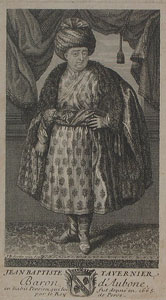 J B Tavernier
What interests Tavernier on his long and adventurous travels? He is a merchant, he writes about the landmarks on the roads in the Middle East and about the dangers caravans have to face on their journey. He also describes the local population, above all the oriental Christians he meets. In this way we get a view of Mesopotamia in the middle of the 17th century and we can travel in the footprints of a jeweller from a family of refugees with their roots in Antwerp. This city, in fact the most important Belgian port, has nowadays become a new hometown for a community of Assyrian-Chaldean refugees, descendants of the oriental Christians described by Tavernier in his Voyages.
Abraham’s Fish
Tavernier leaves Paris in December 1643. On board of a Dutch ship he sails across the Mediterranean Sea and reaches the Levant. In the Syrian town of Aleppo he joins a group of merchants, who are mainly Christians. Early in March 1644 the caravan leaves Aleppo and three days later Tavernier and his companions use ferryboats to cross the river Euphrates at a place he calls Bir. This is now the Turkish town of Birecik, where the modern main road runs and a large bridge is built across the river.
After two more days of travelling the caravan arrives at Urfa, ‘the capital of Mesopotamia’, as Tavernier defines the place. He has now reached the ancient town of Edessa, the place where patriarch Abraham once dwelled. Tavernier visits the ruins of the palace of Abagarus and mentions the Christian legend about this famous ruler. King Abagarus – Abgar the Black – had a portrait of Christ made and promised to support the Messiah against His enemies, the Jews. According to Tavernier, Armenian chronicles in Urfa confirm that under the reign of this Abagarus the Armenians became Christians and were baptized by the apostle who was sent to Abagarus by Christ himself after His resurrection. In the days of Tavernier king Abgar’s castle is largely ruined. Tavernier enters the palace – there is only a large hall with some chambers left – and he notices remnants of mosaic decoration.
On the huge rocky hill that dominates the city he visits the Christian graveyard with the Armenian church. According to local legend, Saint Alexis led a secret life beneath its portal. The main sanctuary of the Armenians lies elsewhere, within walking distance from the town. Here Tavernier refers to the Mor Ephrem monastery. It is well-preserved and surrounded by solid walls. All-Christian Saint Ephrem is buried in a cave nearby. It has been transformed into a chapel, where oil lamps spread a mysterious glow and mass is celebrated every eight hours.
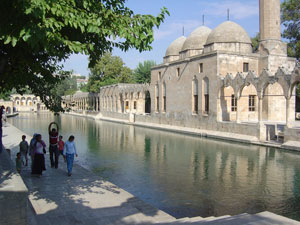 Urfa - Abraham's holy pond
What else does Urfa have to offer? Tavernier wanders through the famous Urfa bazaar. He notices all kinds of merchandise in fine leather with a yellow glow and there is also plenty of excellent wine on offer. On the other hand Urfa seems to be a city in decay. The city walls are made of stone and well-built, but within these walls he walks amidst small, partly ruined houses and he comes across a lot of waste land. All this, he writes, makes that Urfa is not much of a town: it rather resembles a wilderness.
Among Nestorians
On 20 March 1644, the caravan leaves Urfa and travels further east, towards Mardin. Along the way Tavernier and his companions find shelter in the villages Kara and Koushashar. Kara is inhabited by Nestorian Christians and also by some Turkish families who rule the place. Tavernier’s Christian host brings him to the village church, where he meets the Vertabet, the bishop, of Mardin who has come to visit Kara. The church is a sorry sight: the altar consists of two simple boards on four wooden legs and its sole decoration is a painted cloth. This Nestorian church looks like a stable and it is treated as such by the Turks. Tavernier writes that, after mass, the local priest leaves nothing of any value behind, ‘while any Turk who passes here during bad weather would force open the church door, chase his horses inside, burn the altar and take away whatever he can find.’
The village pond in Kara is surrounded by large stone slabs, taken from churches and graves in the neighbourhood. Among them our traveller discovers a tombstone with an epitaph in Latin characters. It marked the grave of a Norman knight. The bishop of Mardin confirms to Tavernier that the Franks, the former Crusaders, were the rulers of Syria in earlier times. But that is all over now. The Mardin region is a fertile plain, Tavernier writes, ‘but the tyranny of the Turks and the raids of the Arabs have thrown the poor Christians into the deepest misery.’
In the village of Koushashar, at a distance of two miles from Mardin, there were once three large monasteries. Tavernier sees that two of them have been partly demolished and the Turks have rebuilt the third and the most beautiful one into a mosque. Koushashar is inhabited by Armenians and also by Nestorian Christians. The latter celebrate mass ‘in the Chaldean language’, as Tavernier writes. Nestorian priests show him two valuable Chaldean Bibles. One of these is almost a thousand years old and after every celebration the priests take care to hide the holy books in a box under the ground. Tavernier is of Protestant stock and so he takes interest in the Holy Scripture, but he is above all a merchant and he wants to buy the age-old Chaldean Bible for two hundred piastres. As tempting as the deal may be for the poor Nestorian priests, they firmly stick to their Christian creed and they turn his offer down.
Nisibis and Nineveh
From Mardin, described en passant by Tavernier as ‘a small walled city on a mountain’, the caravan continues its journey in south-eastern direction. They come along a deserted place, which Tavernier calls Karasera. It can be identified as Dara-Anastasiopolis, a Byzantine border fortress and the site of the battlefield nearby, where the Byzantines chased their Persian rivals from Mesopotamia in the 6th century. Tavernier mentions the remnants of seven churches and enters a large subterranean church. He also descends among large rocks and notices that small caves, each of them with a cross above the entrance, have been carved out in the stone. According to Tavernier, the Ottoman Sultan came to Karasera in 1638 when he was on his way to besiege Baghdad. The Sultan visited the Karasera ruins and destroyed a fortification in the same area, where bands of robbers used to hide and assemble for their raids.
After Karasera the caravan reaches Nisibis, which Tavernier calls Nesbin. Today this is the town of Nusaybin on the Turkish-Syrian border. Tavernier is disappointed: ‘Nesbin is nothing more than the shadow of ancient Nisibis; it is a large village, mainly inhabited by Armenians and Nestorian Christians.’
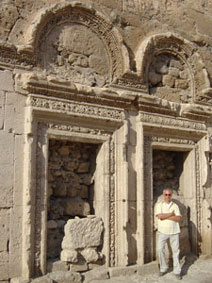 Nusaybin - Mor Yakub church
On the first of April 1644 Tavernier and his companions set out from Nisibis for a five days’ march. It is a difficult journey through the desert plain of Mesopotamia towards Mosul, today the most important town in northern Iraq. Tavernier is not impressed, he writes that Mosul has nothing special to offer. Worth mentioning yet is the fact that the town attracts large groups of merchants, mainly Arabs and Kurds ‘who live in ancient Assyria, which is now called Kurdistan’. He counts four Christian communities in Mosul: Greeks, Armenians, Nestorians and Maronites.
Tavernier crosses the river Tigris at Mosul in order to visit what he calls ‘the sad ruins of a town that once enjoyed such a tremendous reputation, but was not able to preserve a single token of its former glory’. This ghost town is Nineveh, the ancient capital of the Assyrian empire, many centuries BC. What Tavernier sees is merely a jumble of ruins, buried in the sand and stretching a mile along the bank of the Tigris.
Rough People
The glory of Assyria is completely gone and the oriental Christians, as described in this journey from the Euphrates to the Tigris, lead a miserable life under the Ottoman yoke. Tavernier completes his voyage with two alternative itineraries through Mesopotamia, both of them leading to Persian Tauris, i.e. the town of Tabriz in the north-west of Iran.
One alternative route is a follows. After having crossed the river Euphrates, Tavernier heads for Diyarbakir, a town known in former Christian times as Amida. Tavernier is impressed by its double row of fortified walls and asserts that the seventy-two towers in the exterior walls have been erected in honour of the seventy-two disciples of Christ. He seems to like this town. The red leather he finds there is superb, the bread and the wine are excellent and according to him one can enjoy in Diyarbakir a very special dish: young pigeons that taste much better than European ones. He estimates that there are at least twenty thousand Christians in town. The majority of them are Armenians, but there are also Nestorians and a few Syrian-Orthodox Christans or Jacobites as he calls them.
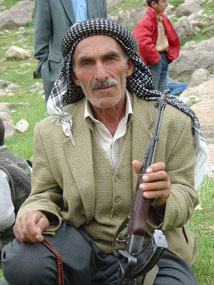 Close to Hakkari - 2004
He concludes this itinerary with a description of the highlands of Kurdistan. The local Kurdish chieftains regard themselves as mighty agha’s, the real princes of this remote border area between the Ottoman empire and the Persian kingdom. They dominate the mountain passes, they have built their fortifications there and they don’t have to fear any attack. Tavernier writes: ‘Generally speaking, the Kurds are a rough people. They are Muslims, but there are among them few mullahs or men of the law to instruct them. Their superstition is so ridiculous that one cannot cut an onion in their presence, it has to be crushed between two stones.’
Bad Road for Merchants
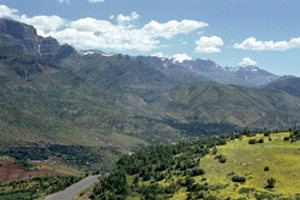 Hakkari mountains - SE Turkey
Tavernier travels from Diyarbakir to Geziré, i.e. Cizre on the Tigris in south-east Turkey. The small town is built on an isle in the river and Tavernier notices that merchants assemble there to buy tobacco and walnuts in the land of the Kurds. Tobacco is grown on the plain and the slopes of the mountains are covered with walnut trees. It’s all big business there, with money and gold in abundance, while nowhere else such amounts of excellent walnuts can be found to be used as dye for cloth.
According to Tavernier, there are no real villages in the Hakkari region. Kurdistan is split up into tribal localities and each clan is engaged in feuds with its neighbours. Tavernier writes: ‘The houses are built apart, each one just as far from the next one as a musket can fire.’ He also sees small vineyards, but they do not produce what he wants: the grapes are dried and there is no wine at all.
Tavernier’s third itinerary continues as follows: Cizre – Amadiya (northern Iraq) – Julamerk (Hakkari town, SE Turkey) – Albayrak (to the east of Bashkale, SE Turkey) – Salmas (NW Iran). This is in fact the shortest route to Persia, but Tavernier cannot recommend it and he also explains why: ‘Merchants seldom dare take this route, for fear of being molested by the chieftains who dominate this area and attack the caravans on their way to Persia.’
As mentioned before, this Hakkari region with its mountain villages along the river Zab was the old homeland of the tribes of Assyrian-Nestorian Christians. In 1648 their religious leader and patriarch, Mar Shimun, settled in the mountain village of Qodshanes, close to Julamerk, and he also had a residence at Khozrawa near Salmas. Tavernier mentions both Julamerk and Salmas as halting-places for the caravans on their trail through the Hakkari mountains towards Persia. But he never mentions the presence of the reputed Nestorian tribes in that area. He couldn’t possibly have missed them if he had really taken the long and winding road upstream along the river Zab. This part of his work is mainly a brief travel report. It shows blind spots, it is probably to some extent based on hearsay.
And yet, who are we to blame this man? Jean Baptiste Tavernier – jeweller, merchant, adventurer, born from refugees from Antwerp – travelled through Mesopotamia in the spring of 1644. He visited the Christians between the Euphrates and the Tigris, he wrote about their fate in Ottoman Turkey and he tried to taste good wine wherever he went. In the mountains of Kurdistan he had little to look for. There was no wine. Les six voyages de Jean Baptiste Tavernier en Turquie en Perse et aux Indes (The Six Travels of J B Tavernier to Turkey, Persia and India). For this article I consulted a copy of the French original (Paris, 1676) in the Central Library of the Katholieke Universiteit Leuven (KUL). Most quotes are taken from Tavernier's third voyage.
|

 Homeland
Homeland  Turkey
Turkey  Tavernier in Turkey
Tavernier in Turkey

 Homeland
Homeland  Turkey
Turkey  Tavernier in Turkey
Tavernier in Turkey